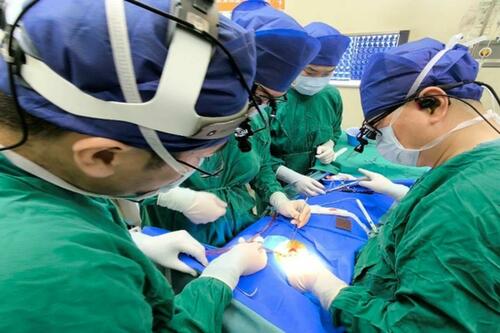Robot Nearly Decapitates Man In Gruesome Surgery Fail
In a shocking incident that underscores the growing dangers of industrial automation, Chinese surgeons have pulled off what medical experts are calling a miracle surgery after a robotic arm nearly decapitated a factory worker in a horrific accident in May that has only now come to light through China’s state-controlled media apparatus.
The gruesome workplace incident left the unidentified man with what doctors described as an “internal decapitation” – his cervical vertebrae completely severed and critical arteries damaged, with only soft tissue keeping his head attached to his body. The worker immediately suffered paralysis and went into cardiac arrest at the scene, according to South China Morning Post, citing the Chinese medical publication Yixue Jie.
Medical teams at Shanghai Changzheng Hospital faced a gory challenge when the patient arrived in critical condition, with both of his vertebral arteries obstructed and his blood pressure having collapsed to life-threatening levels.
Advanced imaging revealed the full scope of the catastrophic injuries: one artery had completely ruptured and was blocked by bone fragments and blood clots, while the other was stretched to its breaking point and barely maintaining any blood flow to the brain.
“We have looked through much literature at home and abroad, but have never come across a case of such severe cervical vertebra separation, let alone one that survived after treatment,” said Chen Huajiang, director of the hospital’s cervical spine surgery department, as quoted by SCMP.
The medical team determined that emergency surgery represented the patient’s only shot at survival, but the procedure carried enormous risks that could have proven fatal in seconds. Any disruption of the existing blood clots could have triggered catastrophic hemorrhaging – with doctors estimating potential blood loss of up to 2,000 milliliters in a matter of seconds.
Adding to the complexity, extensive damage to the skin on the back of the patient’s neck meant that opening the surgical site risked introducing deadly bacteria into the cerebrospinal fluid, potentially causing a fatal brain infection. The patient’s precarious state also prevented doctors from conducting standard pre-operative imaging and basic medical assessments.
Despite these overwhelming challenges, a multidisciplinary surgical team took the extraordinary risk on June 18, performing a marathon three-hour operation to remove the life-threatening clot, realign the shattered cervical bones, and stabilize the spine using two auxiliary plates, marking the first reported use of this technique in such a severe case.
“Although it seems that we were merely moving bones, surrounding blood vessels and nerves were also being tugged as we operated. We had to avoid secondary injuries while striving for a high success rate,” Chen explained.
Despite warnings from some in China about the risks of defective combat robots, the government is aggressively advancing AI-driven battlefield systems. Recent tactical exercises featuring “robotic wolves” underscore Beijing’s rapid push toward unmanned warfare.
The China’s 76th Group Army’s recent drills focused on battlefield coordination between human personnel and autonomous technologies designed for reconnaissance, strategic point clearing, fire support and breaching defensive positions, according to official military statements. These exercises represent China’s latest and most aggressive effort to advance unmanned warfare capabilities as part of the growing global arms race in military robotics.
Tyler Durden
Tue, 08/19/2025 – 20:30ZeroHedge News






 T1
T1



